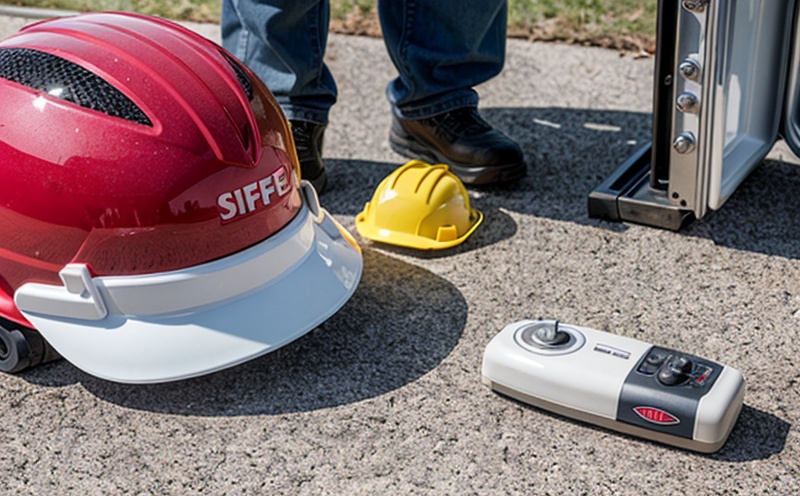ISO 12402-9 Safety Performance Testing of Lifejackets
The ISO 12402 series is a set of standards that provide comprehensive guidance for the testing and certification of safety equipment used in maritime environments. Specifically, ISO 12402-9:2015 focuses on the safety performance testing of lifejackets. This standard ensures that lifejackets meet stringent requirements to protect individuals in potentially life-threatening situations at sea.
The testing procedure outlined in ISO 12402-9 involves several critical stages aimed at evaluating the buoyancy, stability, and overall functionality of a lifejacket. The buoyancy test is one of the most crucial aspects, where the lifejacket must be able to support an individual for extended periods without submerging below water level. This ensures that in case of an emergency, the wearer remains afloat until rescue arrives.
Another key component of ISO 12402-9 is the stability test. During this test, the lifejacket must maintain its position and not roll or tip excessively when subjected to simulated conditions such as waves and wind. This ensures that even in turbulent waters, the lifejacket provides reliable support.
The tests are conducted using controlled environments replicating real-world scenarios. For instance, the buoyancy test is performed in a pool with water temperature close to 15°C, which simulates cold ocean conditions. The stability test uses a pendulum-like apparatus designed to mimic waves and other environmental factors that could affect a lifejacket’s performance.
The standard also covers additional tests such as the flame resistance test, where the lifejacket is exposed to flames for a specified duration to ensure it does not catch fire or melt. This ensures that the lifejacket remains functional even in an extremely hot environment like a fire on board a vessel.
Testing laboratories follow these stringent protocols meticulously to ensure compliance with ISO 12402-9. Rigorous documentation and reporting are required, detailing each test’s parameters, results, and any deviations from the standard. This comprehensive approach guarantees that only lifejackets meeting the highest safety standards are certified for use.
The importance of these tests cannot be overstated in ensuring maritime safety. According to the International Maritime Organization (IMO), thousands of lives could be saved annually by adhering strictly to such safety protocols. ISO 12402-9 plays a vital role in this context, providing a robust framework for assessing lifejacket performance.
- Lifejackets are critical components in maritime safety systems, ensuring the survival of crew and passengers during emergencies.
- The standard is essential for manufacturers to ensure their products meet international safety standards before being marketed globally.
- Certification under ISO 12402-9 can enhance a company’s reputation as a leader in maritime safety equipment, boosting market confidence.
Compliance with this standard is not only a requirement for manufacturers but also a commitment to the welfare of seafarers. By adhering to these stringent tests and protocols, companies contribute significantly to reducing maritime accidents and enhancing overall safety at sea.
Benefits
The implementation of ISO 12402-9 brings numerous advantages for manufacturers, quality managers, compliance officers, R&D engineers, and procurement teams involved in the lifejacket industry. One of the primary benefits is enhanced reliability and performance.
By adhering to this standard, manufacturers ensure that their lifejackets meet rigorous safety requirements, thereby increasing customer trust and satisfaction. This can lead to increased market share and brand loyalty. Additionally, compliance with international standards like ISO 12402-9 can open doors to new markets where stringent safety regulations are in place.
For quality managers and R&D engineers, this standard provides a clear set of guidelines for product development and testing. It helps in identifying potential issues early on in the design phase, ensuring that all aspects of lifejacket performance meet or exceed expectations. This can lead to more efficient production processes and reduced costs associated with rework.
Compliance also facilitates smoother regulatory compliance processes, reducing the risk of recalls or product bans. For procurement teams, it ensures that they are sourcing high-quality materials and components from reliable suppliers who adhere to these standards. This reduces the likelihood of substandard products being delivered, ensuring that only safe and effective lifejackets reach end-users.
Ultimately, adherence to ISO 12402-9 enhances overall maritime safety by providing robust protection for individuals in potentially dangerous situations at sea.
Competitive Advantage and Market Impact
- Enhanced Reputation: Compliance with ISO 12402-9 enhances a company’s reputation as a leader in maritime safety equipment, fostering market confidence.
- Better Consumer Trust: By adhering to stringent standards, manufacturers can build trust among consumers, leading to increased market share and brand loyalty.
- Access to New Markets: Compliance with international standards opens doors to new markets where stringent safety regulations are in place, broadening the company’s customer base.
- Reduced Risk of Recalls: By ensuring that products meet rigorous safety requirements, companies can significantly reduce the risk of product recalls or bans, protecting their brand integrity.
Use Cases and Application Examples
The ISO 12402-9 standard is applicable to various types of lifejackets used in maritime environments, including but not limited to:
- Inflatable Lifejackets: These are designed for quick inflation by the wearer. They must meet stringent requirements for rapid deployment and reliability.
- Non-Inflatable Lifejackets: These lifejackets rely on their inherent buoyancy without requiring inflation. They must demonstrate consistent performance across all environmental conditions.
The standard also applies to lifejackets used in different maritime sectors, including commercial shipping, recreational boating, and offshore oil rigs. In each of these sectors, the criticality of lifejacket safety cannot be overstated. For instance, in commercial shipping, where accidents can have severe consequences for both human lives and the environment, ISO 12402-9 ensures that every lifejacket meets the highest standards.
In recreational boating, compliance with this standard is crucial to ensure the safety of leisure enthusiasts who might find themselves in dangerous situations. In offshore oil rigs, where workers operate in harsh and unpredictable environments, reliable and robust lifejackets are essential for survival.





